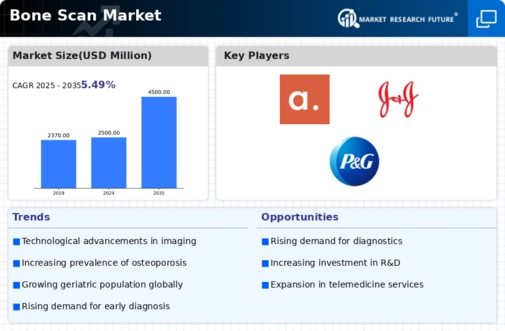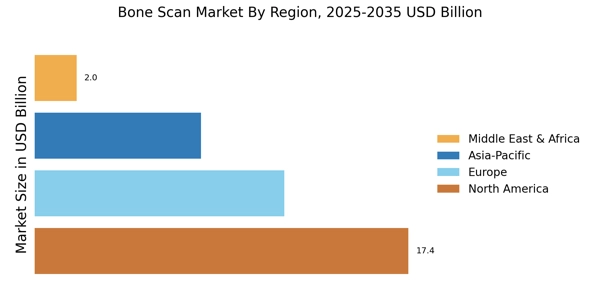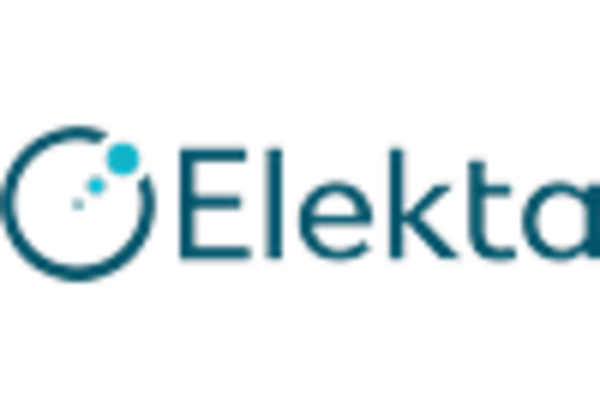Rising Geriatric Population
The Bone Scan Market is significantly influenced by the rising geriatric population, which is more susceptible to bone-related ailments. As life expectancy increases, the number of elderly individuals is projected to rise dramatically, leading to a higher prevalence of conditions such as osteoporosis and fractures. This demographic shift necessitates enhanced diagnostic tools, including bone scans, to effectively monitor and manage these conditions. The World Health Organization estimates that by 2050, the global population aged 60 years and older will reach 2 billion, underscoring the urgent need for effective healthcare solutions. Consequently, the demand for bone scans is likely to surge, driving growth in the Bone Scan Market as healthcare systems adapt to meet the needs of this expanding population.
Focus on Preventive Healthcare
The Bone Scan Market is witnessing a shift towards preventive healthcare, which emphasizes early detection and management of bone-related conditions. This trend is driven by a growing recognition of the importance of maintaining bone health, particularly among aging populations. Preventive measures, including regular screenings and lifestyle modifications, are becoming more prevalent, leading to an increased utilization of bone scans. Healthcare providers are increasingly recommending bone density tests and scans as part of routine health assessments, which is likely to enhance patient outcomes. The emphasis on preventive care is expected to create new opportunities within the Bone Scan Market, as more individuals seek proactive measures to monitor their bone health and prevent potential complications.
Technological Advancements in Imaging
The Bone Scan Market is experiencing a transformative phase due to rapid technological advancements in imaging techniques. Innovations such as hybrid imaging systems, which combine bone scans with other modalities like CT and MRI, enhance diagnostic accuracy and provide comprehensive insights into bone health. These advancements not only improve the detection of bone diseases but also facilitate better treatment planning. The integration of artificial intelligence in image analysis further streamlines the diagnostic process, potentially reducing the time required for interpretation. As a result, healthcare providers are increasingly adopting these advanced imaging technologies, which is likely to drive growth in the Bone Scan Market. The market is projected to expand significantly, with estimates suggesting a compound annual growth rate of over 5% in the coming years.
Increasing Prevalence of Bone Disorders
The rising incidence of bone disorders, including osteoporosis and fractures, is a critical driver for the Bone Scan Market. As populations age, the prevalence of these conditions is expected to increase, leading to a higher demand for diagnostic imaging services. According to recent data, osteoporosis affects approximately 200 million individuals worldwide, highlighting the urgent need for effective screening and monitoring solutions. Bone scans play a pivotal role in diagnosing these disorders, allowing for early intervention and management. This growing patient population is likely to propel the demand for bone scans, thereby contributing to the overall expansion of the Bone Scan Market. Furthermore, increased awareness about bone health and preventive measures is expected to further stimulate market growth.
Increased Investment in Healthcare Infrastructure
The Bone Scan Market is benefiting from increased investment in healthcare infrastructure, particularly in developing regions. Governments and private entities are recognizing the importance of advanced diagnostic tools in improving healthcare outcomes. Investments in hospitals and diagnostic centers are leading to the acquisition of state-of-the-art imaging equipment, including bone scan technology. This expansion of healthcare facilities is expected to enhance access to diagnostic services, thereby increasing the utilization of bone scans. Furthermore, as healthcare systems evolve, there is a growing emphasis on integrating advanced imaging modalities into routine practice. This trend is likely to bolster the Bone Scan Market, as improved infrastructure facilitates better patient care and encourages the adoption of innovative diagnostic solutions.


















Leave a Comment